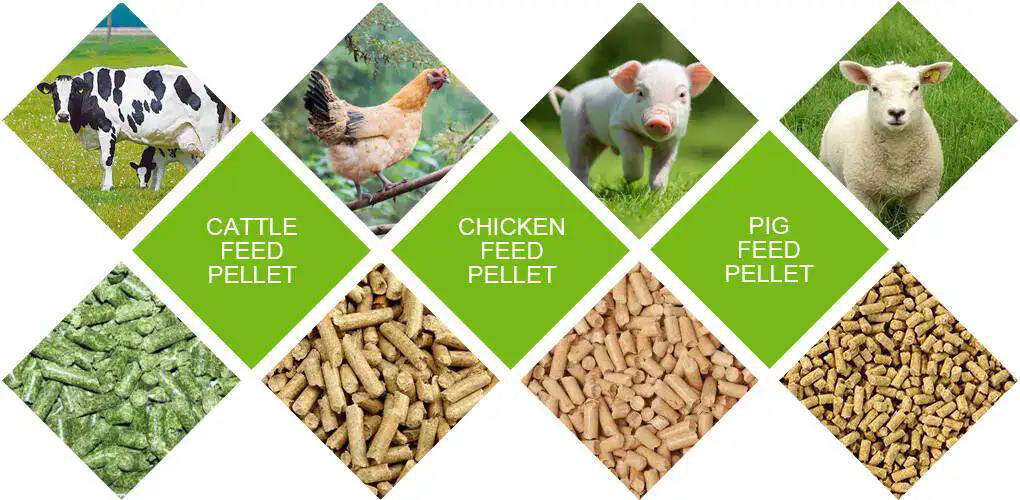poultry feed plant
A poultry feed plant is a factory specialized in producing and processing feed for poultry such as chickens, ducks, and geese. These plants typically
poultry feed plant Introduction
A poultry feed plant is a factory specialized in producing and processing feed for poultry such as chickens, ducks, and geese. These plants typically use various ingredients such as grains, legumes, proteins, vitamins, and minerals to produce feed suitable for the growth and development of poultry through processes like mixing, grinding, and pelleting.The products of poultry feed plants are primarily used to feed poultry on farms and by farmers, meeting their nutritional needs and promoting growth and egg production. These plants play a crucial role in poultry feed production, directly influencing the development of the poultry farming industry and the quality of poultry products.


Characteristics of poultry feed plant
Diverse ingredients
Poultry feed plants utilize a variety of ingredients such as grains, soybeans, proteins, vitamins, and minerals to meet the nutritional requirements of different poultry species.
Specialized processing
These plants employ specialized processing techniques such as mixing, grinding, and pelleting to produce feed that is suitable for the digestion and growth of poultry.
Customized formulations
Poultry feed plants can formulate feed tailored to the specific nutritional needs of different poultry species and production stages.
Quality control
These plants implement strict quality control measures to ensure that feed products meet quality standards and nutritional requirements.
Nutritional expertise
Poultry feed plants often employ nutritionists and animal scientists who specialize in formulating balanced and nutritious feed recipes.
Technological innovation
Many poultry feed plants invest in advanced equipment and technologies to improve production efficiency and product quality.
Environmental sustainability
Poultry feed plants are increasingly adopting sustainable practices such as using eco-friendly ingredients and reducing waste.
Regulatory compliance
These plants adhere to regulatory requirements related to feed production, ensuring the safety and quality of feed products.


Structure of poultry feed plant
Raw material receiving section
This area is responsible for receiving and storing various raw materials used in poultry feed production, such as grains, soybeans, and other ingredients.
Grinding and mixing section
Raw materials are processed in this section through grinding and mixing equipment to achieve the desired particle size and homogenous mixture required for feed production.
Pelleting or extrusion section
Some poultry feed plants feature a pelleting or extrusion section. Here, mixed ingredients are shaped into pellets or extrusions to facilitate easier feeding and better digestion for poultry.
Conditioning section
In this section, the feed pellets or extruded products may undergo conditioning processes such as steam treatment to improve their digestibility and nutritional value.
Cooling and drying section
After conditioning, the feed products are cooled and dried to reduce moisture content and ensure stability during storage and transportation.
Packaging section
The final step involves packaging the finished feed products into bags or other containers for distribution to customers.
Quality control and laboratory
Poultry feed plants typically include a quality control and laboratory section. Here, raw materials and finished products are analyzed to guarantee they meet quality standards and nutritional requirements.
Administrative and support facilities
These include offices, warehouses, maintenance workshops, and employee amenities to support the operation of the poultry feed plant.


Advantages of poultry feed plant
Customization
Poultry feed plants offer custom feed formulas and products to meet the nutritional needs of various poultry breeds and stages.
Quality assurance
Poultry feed plants implement strict quality control measures to ensure that feed products meet quality standards and nutritional requirements, ensuring poultry health and productivity.
Technological innovation
Many poultry feed plants invest in advanced production equipment and technology to improve production efficiency and product quality, maintaining competitiveness in the market.
Environmental sustainability
Poultry feed plants utilize environmentally friendly technologies and methods to minimize resource use and environmental pollution. This approach aligns with environmental regulations and bolsters the brand’s image.
Stable supply
Poultry feed plants have developed stable supply chains and distribution networks. These ensure the timely supply of feed products, which is crucial for supporting the sustainable development of the poultry farming industry.
Nutritional expertise
Many poultry feed plants have nutrition experts and veterinary teams who can provide professional nutrition consulting and technical support to help improve poultry farming profitability.
Market adaptability
Poultry feed plants can adjust product structures and production plans flexibly according to market demand and industry changes, meeting the constantly changing needs of customers.
Comprehensive service
Poultry feed plants emphasize communication and cooperation with customers. They offer comprehensive pre-sales consultation and after-sales service to build long-term, stable cooperative relationships.
Application of poultry feed plant
Typically, the production of animal feed processing plant uses raw materials such as corn, soybeans, wheat, and other nutrients as the formula. Our small feed mill plant are specially used to produce feed for poultry, livestock, pigs, horses, cattle, sheep, chickens, ducks, goose and other animals.For different animals, with different growth cycles, (chicks, suckling pigs, calves, etc.), the feed pellet size required is different, but our feed production line only needs to replace ring molds with different apertures or use a pellet crumbler to reach the required size.

Parameter of poultry feed plant
| Model | Capacity | Main Motor Power | Feeder Motor Power | Conditioner Power | Dia. of Ring Die | Pellet Size |
| SZLH250 | 1-2T/H | 22KW | 0.75kw | 1.5kw | 250mm | 2-12mm |
| SZLH320 | 3-4T/H | 37KW | 1.5kw | 2.2kw | 320mm | 2-12mm |
| SZLH350 | 5-7T/H | 55KW | 1.5kw | 3kw | 350mm | 2-12mm |
| SZLH420 | 8-12T/H | 110KW | 1.5kw | 7.5kw | 420mm | 2-12mm |
| SZLH508 | 10-18T/H | 160KW | 2.2kw | 11kw | 508mm | 2-12mm |
| SZLH558 | 15-25T/H | 180KW | 2.2kw | 11kw | 558mm | 2-12mm |
| SZLH678 | 20-30T/H | 220KW | 2.2kw | 11kw | 678mm | 2-12mm |
| SZLH768 | 25-42T/H | 280KW | 2.2kw | 11kw | 768mm | 2-12mm |








